U.S. Department of Transportation
Federal Highway Administration
1200 New Jersey Avenue, SE
Washington, DC 20590
202-366-4000
Federal Highway Administration Research and Technology
Coordinating, Developing, and Delivering Highway Transportation Innovations
|
Research & Technology Transporter This newsletter is an archived publication and may contain dated technical, contact, and link information. |
|
| Publication Number: N/A Date: March 2004 |
Publication Date: March 2004
|
On freeways, light rain or snow can reduce traffic speed by approximately 10 percent. In heavy snow, freeway speeds can decline by approximately 40 percent. To mitigate the impacts of weather, especially winter weather on roadways, transportation professionals increasingly are turning to intelligent transportation systems (ITS). Although researchers in the United States are developing many of these technologies, transportation agencies in other countries also are working on ITS technologies and other approaches that could improve the safety and efficiency of the Nation’s transportation system.
To evaluate innovative technologies and practices in other countries, representatives from the Federal Highway Administration (FHWA) recently traveled to Japan under FHWA’s International Technology Exchange Program. Key findings from the trip are available in a new report, Intelligent Transportation Systems and Winter Operations in Japan (FHWA-PL-03-016). The American Association of State Highway and Transportation Officials, the Transportation Research Board (TRB), FHWA, and several members of the private sector and academia jointly sponsored the trip.
The report offers observations on the technologies and policies that Japanese transportation officials are using to improve road maintenance and operations during the winter, such as in Hokkaido—the northernmost island in Japan. Travelers in Hokkaido who are stopped at rest areas can use specially provided computer terminals to access real-time images and information about road surfaces and weather conditions on mountain passes. Japanese transportation officials also make extensive use of variable speed limits, which are adjusted based on weather and pavement surface condition.
The report notes several advances that Japan has made in the equipment used for winter maintenance. Japanese engineers, for example, have modified the design of vehicles that have snowplows so that the truck cab sits over the engine on a chassis. This cab-over engine provides the operator with an unobstructed forward view of the roadway. Some vehicles also have dual front axles, which enable the plow drivers to remove snow while traveling at high speeds.
Based on observations during the trip, the scan team recommended further investigation into several of Japan’s technologies for use in the United States, including plow designs, salinity indicators, and road delineators. The team also proposed further evaluation of communication technologies, such as Road Web Markup Language (RWML), which organizes road-related information so officials can distribute it easily on the Internet to transportation administration offices and maintenance garages.
In addition, the scan team determined areas where the United States, Japan, and Europe could benefit from conducting further investigations and improvements. The team, for example, recommended an increase in the amount of data shared between Internet sites devoted to roadway weather information and information collected by national meteorological agencies. This collaboration would facilitate the development of more comprehensive reports.
Based on the scan team’s success in Japan, FHWA is planning another trip in 2006 in coordination with the Winter Road Conference in Italy, sponsored by the World Road Association. This trip will focus on European technologies.
To download a copy of the report, visit http://international.fhwa.dot.gov/Pdfs/converted_to_html/scanreports/intelligent/chapter1.htm.
Paul Pisano 202-366-1301 paul.pisano@fhwa.dot.gov
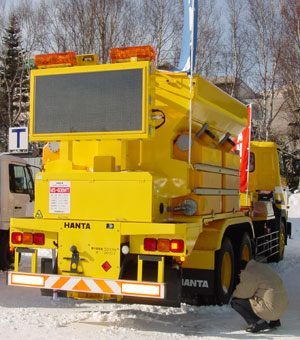 |
| Snowplows with dynamic message sign and additional lighting attached to the back of the vehicle, such as the one shown above, increase visibility at the rear of the vehicle. |
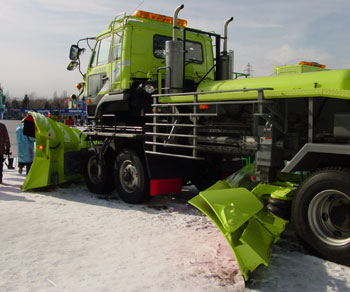 |
| A snowplow with a cab-over design, twin front axles, and a plow located under the body of the vehicle is shown above. |
In 2002, the Federal Highway Administration’s (FHWA) Office of Bridge Technology recorded almost twice as many regular and continuous span bridges made from concrete than steel in the United States. In the same year, however, FHWA listed 44,650 steel bridges as structurally deficient, compared to only 19,749 substandard concrete bridges. Although steel bridges are as structurally sound as those built from concrete, many were built more than 100 years ago when steel was the material of choice for bridges. As a result, many of the Nation’s steel bridges are outdated or overloaded, and require consistent maintenance and technological innovation.
To help improve the condition of steel bridges in the United States and elevate the performance of the industry, FHWA’s Office of Bridge Technology recently held a collaborative meeting with the National Steel Bridge Alliance (NSBA) at the Turner-Fairbank Highway Research Center in McLean, VA. The meeting provided a forum to exchange information on new technologies and an opportunity to identify issues, gaps, weaknesses, and research needs in steel bridge technology. Twenty-eight professionals attended the event, including representatives from FHWA, several State departments of transportation (DOTs), the steel industry, and academia.
Several new technologies were introduced at the meeting, such as a two-coat painting system that could replace the traditional three-coat system, which requires a base, primer, and final layer of paint. Using new paints made with solid compounds that bond more easily to steel, State DOTs could save money by applying two, rather than three, coats. Attendees also discussed the potential for deploying automated inspection systems—such as scanners, manual and robotic, and computers—that would enable inspectors to retrieve information on various components of a bridge from remote locations. With technologies like these, inspectors could monitor the quality of work during the construction process without being at the site, creating a safer and more efficient work environment.
Representatives from FHWA and NSBA also discussed projects and goals for the upcoming year and identified opportunities for collaboration. The organizations proposed working together to implement training courses and develop a manual on steel bridge design and construction.
Many participants felt that the meeting was a first step toward strengthening the steel sector of the bridge engineering program. In addition, participants said that the meeting demonstrated that FHWA cares about the steel industry and its partnership with the steel bridge community. When asked whether the dialogue between FHWA and NSBA should continue in a formalized setting, many attendees agreed that the meeting was an important start and felt that semiannual meetings would be advantageous. Although another meeting has not been scheduled yet, it may become an annual or semiannual event.
Vasant Mistry 202–366–4599 vasant.mistry@fhwa.dot.gov
Urban freeways make up less than 3 percent of total urban highway mileage but carry approximately 20 percent of the Nation’s traffic. And as the population of the United States increases and demand for highway travel continues to grow, particularly in metropolitan areas, effective freeway management and operations are critical to improving the Nation’s mobility and roadway safety. Over the last three decades, transportation agencies have changed significantly the way they manage and operate freeways. Since the late 1960s, freeway management has broadened in scope to include asset management and a more proactive, regional approach to addressing potential problems. In recent years, transportation professionals also have developed and implemented new management strategies and technologies, such as variable speed limit signs, electronic toll collection, and other intelligent transportation systems.
To help freeway practitioners stay up to speed on these changes, the Federal Highway Administration’s (FHWA) Office of Transportation Management recently revised its Freeway Management and Operations Handbook (FHWA-OP-04-003), which was last published in 1997. Now in its third edition, the revised handbook provides readers with a comprehensive understanding of the various institutional and technical issues associated with the planning, design, implementation, operation, and management of freeway networks. FHWA developed the handbook as a tool for transportation managers, supervisors, engineers, planners, or technicians involved with issues or decisions that directly or indirectly influence the performance of freeway facilities.
The revised handbook includes an updated overview of available operational strategies, tools, intelligent transportation systems, traffic management techniques, and opportunities to improve the daily operation of freeway facilities. FHWA devoted several chapters to roadway operational improvements, high occupancy vehicle treatments, performance monitoring, transportation management centers, and management of ramps, lanes, traffic incidents, and emergencies. One chapter, for example, highlights the elements involved in managing traffic during planned special events. The chapter also describes implementation and operational considerations for special events, including post-event activities.
In addition, the handbook covers broader topics related to freeway management, including surveillance of traffic flow, regional integration of systems to share roadway information, communication networks, and information dissemination in support of managing travel on freeway facilities. A chapter on road improvements, for example, describes potential changes to the geometric configuration or physical characteristics of a roadway to enhance freeway performance and safety. Options include changing the alignment to improve the sight distance for drivers and to decrease interruptions in traffic flow, constructing auxiliary lanes in advance of freeway exit ramps, allowing drivers to use roadway shoulders as travel lanes, and installing ramp meters to regulate the flow of traffic entering freeway facilities.
To download a copy of the handbook, visit FHWA’s “Freeway Management Program” Web site at http://ops.fhwa.dot.gov/Travel/traffic/freeway_management.htm. For more information on the revisions in the new edition of the handbook, visit the ITS “Cooperative Deployment Network” Web site at www.nawgits.com/icdn/fmoh.html.
Jon T. Obenberger 202–366–2221 jon.obenberger@fhwa.dot.gov
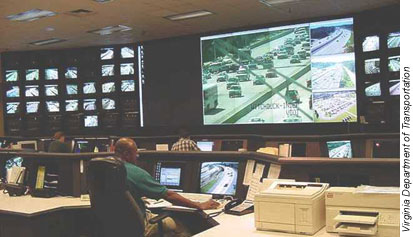 |
| In traffic management centers such as this one, agencies compile traffic information and work with the public and other stakeholders to manage and control congestion. The revised Freeway Management and Operations Handbook describes the role of these centers in freeway management. |
Traffic control devices (TCDs) include signs, signals, pavement markings, and other equipment that transportation agencies install on streets, highways, pedestrian facilities, or bikeways to regulate, warn, or guide traffic. Transportation agencies design TCDs to provide the information that drivers need in various road situations, using messages that drivers can recognize instantly, whether they see the TCD from a distance, at night, or under adverse weather conditions on various types of roads and at different speeds and traffic levels. The Federal Highway Administration (FHWA), along with several State and local agencies, universities, and private organizations, is conducting cutting-edge research on TCDs to understand their effectiveness with drivers and to improve the design and deployment of TCDs.
To showcase current research and the latest findings, FHWA’s Office of Research, Development, and Technology (RD&T) recently hosted an open house for members of the National Committee on Uniform Traffic Control Devices—a group formed to assist in the development of uniform standards, guides, and warrants for TCDs. The event, which was held at the Turner-Fairbank Highway Research Center (TFHRC) in McLean, VA, included several technical presentations and demonstrations of the research techniques used in laboratories at TFHRC.
Carl Andersen, a research physicist at FHWA, updated participants on a project to help enhance nighttime visibility. This research was initiated to validate earlier findings related to the use of fluorescent pavement markings that were activated by ultraviolet vehicle headlights. While the earlier studies showed improved roadway visibility, the recent study, which included various emerging headlight technologies under varying weather conditions, showed that markings did not maintain their fluorescence for more than a few weeks when placed in service. Although this approach to increasing the visibility of pavement markings did not prove feasible, the study yielded valuable insights relative to the effects of various headlight systems and glare on drivers in oncoming traffic.
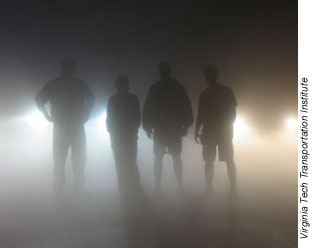 |
| FHWA is conducting studies on the ability of drivers to see roadway markings using various headlight systems. This photograph showing people standing in the dark illuminated by headlights demonstrates the difference between regular tungsten-halogen headlights and high-intensity discharge headlights (left), which produce a whiter, broader beam. |
Another presentation, given by Robert Ferlis, technical director of FHWA’s Office of Operations RD&T, provided insight into the future of TCDs as part of collision avoidance systems for intersections. Collision avoidance systems use advanced technologies to capture the attention of drivers at risk of disregarding or violating traffic signals or signs; warn other motorists about potential conflicts with violating drivers; advise motorists about unsafe times to turn at traffic signals or to move from stop signs; and alert drivers of potential conflicts with pedestrians or bicyclists. Open house participants also had the opportunity to see how researchers at TFHRC are using the Highway Driving Simulator (HDS) to refine the designs for these innovative systems. Development efforts are ongoing, with field tests of the intersection collision avoidance systems planned for 2005 on public roads.
Other presentations described FHWA’s efforts to develop a protocol for evaluating TCDs and the status of TCD research being done through the Transportation Research Board. In addition, participants had the opportunity to see FHWA’s methods for testing roundabout signing and experiments to determine the effectiveness of fluorescent sign materials as they age.
More than 70 people attended the open house, including engineers from State and local agencies and the private sector, and other transportation professionals interested in TCDs and related strategies. For more information, visit TFHRC’s Web site at www.tfhrc.gov.
Kenneth Opiela 202–493–3371 kenneth.opiela@fhwa.dot.gov
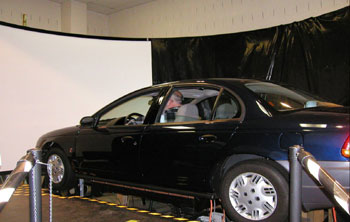 |
| One of the laboratory tours featured the Highway Driving Simulator shown here. FHWA uses the simulator to test driver responses to various roadway situations and traffic control devices, such as collision avoidance systems. |
The first 72 hours after a road crew places concrete on a roadway are critical to the pavement’s long-term performance. Since the strength of the concrete is relatively low during the first hours after construction, changes in environmental conditions can cause cracking and shorten the pavement’s service life. Finding a way to predict the complex interactions among materials, design, construction techniques, and environmental conditions during the early-age period is a key factor in producing durable concrete pavements and preventing premature failure.
To address this challenge, in 1996 the Federal Highway Administration (FHWA) sponsored the development of HIPERPAV (HIgh PERformance PAVing), a software tool designed to help engineers predict pavement behavior and prevent performance problems. In spring 2004, FHWA plans to release HIPERPAV II, the newest version of the software.
An example of some of the enhancements that FHWA has made to the original program that now are a part of HIPERPAV II include the addition of two major modules. One of the new modules will help transportation professionals predict the performance of joint plain concrete pavement as it is affected by early-age factors. The other module will help in the prediction of early-age behavior—behavior within the first 72 hours—and early life—behavior within the first year—of continuous reinforced concrete pavement.
FHWA also has incorporated two additional studies in the updated program. The first study focuses on predicting dowel bearing stress as a function of environmental loading during early age. The second study focuses on the optimization of concrete paving mixes as a function of strength and cost. Additional functionality includes:
For more information on HIPERPAV II, visit https://www.fhwa.dot.gov/pavement/pccp/hipemain.cfm. To download a trial version of the current HIPERPAV, visit www.hiperpav.com.
Fred Faridazar 202–493–3076 fred.faridazar@fhwa.dot.gov
Mauricio Ruiz 512–451–6233 mauricio@thetranstecgroup.com
Transportation professionals strive every day to increase safety and mobility on the Nation’s roads by implementing new technologies, reducing work zone delays and traffic incidents, and researching new materials and hardware. Because of their efforts, the public enjoys a transportation system that enables them to access even the most remote areas.
Although every transportation professional is vital to the success of the road system, some go beyond the call of duty. The Federal Highway Administration (FHWA) recently recognized several of these dedicated professionals at the Administrator’s Awards Ceremony in Washington, DC. FHWA Administrator Mary E. Peters presented awards to more than 50 individuals and four teams, including employees from the Offices of Bridge Technology, Pavement Technology, Natural and Human Environment, Project Development and Environmental Review, Transportation Management, Safety Design, and Infrastructure Research and Development.
John McAvoy, a design engineer in FHWA’s Connecticut division office, received one of the Administrator’s Awards for Superior Achievement, which recognizes employees for their initiative, hard work, dedication, and commitment. McAvoy contributed to the Connecticut Department of Transportation’s (ConnDOT) Design Exception and Scope Review committees and led a ConnDOT team that specialized in the implementation of context-sensitive solutions. As the team leader, he successfully promoted new technologies to improve traffic safety and efficiency, such as the use of roundabouts.
The Strive for Excellence Award recognizes individuals, groups, and teams who help foster quality at the agency. Indiana’s Hyperfix Team was one of the winners of this award. The team, which comprised representatives from FHWA, the Indiana Department of Transportation, the Indiana Public Works Division, the Indianapolis Metropolitan Planning Organization, and several private firms, rehabilitated more than 56 kilometers (35 miles) of I–70 and I–65 in Indianapolis, IN. The team determined that closing the roads would increase safety and lead to significant cost and time savings. To limit the impact on the public, the team coordinated the closure of other projects, made strategic improvements to the city street system, and established a park-and-ride program. In addition, the team coordinated an extensive media campaign that explained the reasons for the road closures, outlined alternative routes, and promoted the park-and-ride program. The Hyperfix team completed the project in just 55 days—30 days ahead of schedule—with savings of more than $1 million per day.
FHWA also presented the Heartland Award, which honors employees lost in the bombing of the Alfred P. Murrah Federal Building in Oklahoma City, OK. FHWA presented California Division Administrator Gary Hamby with the Heartland Award for his role in directing the largest and most complex Federal-aid program in the Nation, and for overseeing $2.6 billion in major transportation projects. Formerly, as director of Field Services-West, Hamby successfully improved the environmental review process throughout the western United States. As deputy regional administrator in Atlanta, GA, Hamby facilitated communication between the U.S. Coast Guard and the Mississippi DOT, to ensure the successful completion of a highway project on I–10. In 1999, Hamby became the chief of the State Programs Division at the National Highway Institute, where he set new standards for customer service and responsiveness, and started initiatives to evaluate the agency’s services.
Also at the awards ceremony, Secretary Norman Y. Mineta of the U.S. Department of Transportation paid special tribute to seven FHWA employees from the New York division office who received 9-11 Transportation Medals for meritorious service and outstanding achievement in response to the attacks of September 11, 2001. In addition, Administrator Peters gave special recognition to Bud Wright for winning the President’s Meritorious Executive Award, in honor of his superior leadership and sustained accomplishments in the development of the Transportation Equity Act for the 21st Century (TEA-21) reauthorization provisions.
Nancy Singer 202-366-0660 nancy.singer@fhwa.dot.gov
Ruth Burley 202-366-1193 ruth.burley@fhwa.dot.gov
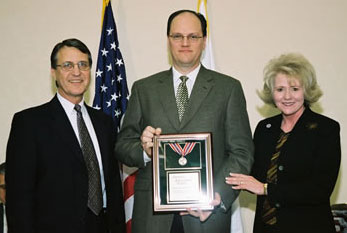 |
| FHWA Administrator Mary E. Peters and Associate Administrator for Research, Development, and Technology Dennis Judycki, director of the Turner-Fairbank Highway Research Center, present an Administrator’s Awards to Raymond Krammes (center) of the Office of Research, Development, and Technology for his outstanding performance in the research, development, communication, and coordination of the Interactive Highway Safety Design Model. |
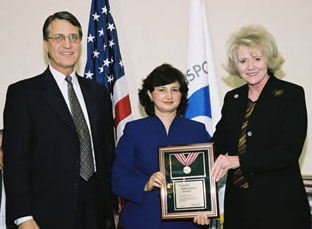 |
| FHWA Administrator Mary E. Peters and Associate Administrator for Research, Development, and Technology Dennis Judycki, director of the Turner-Fairbank Highway Research Center, present an Administrator’s Awards to Sheila Duwadi (center) of the Office of Research, Development, and Technology, for her sustained contribution in program management, demonstrated by her development of a long-term research plan to improve the physical security of the Nation’s highway bridges. |
Transportation professionals rely on numerous information sources, such as journals, reports, maps, and government regulations, to collect needed information. With the advent of the Internet, much of this information is available online. The sheer volume of material that can be downloaded off the Internet, however, can be overwhelming. Without proper training, transportation professionals could waste valuable time and resources searching for information. Although some transportation libraries provide tutorial sessions or materials that teach users how to find information, these training events often focus only on the contents of a specific library. Many transportation professionals, instead, could use instructional sessions on the entire Internet as a resource for transportation information.
To meet this need, the Federal Highway Administration’s National Highway Institute (NHI), in conjunction with several other agencies, has introduced a new course, Working Smarter: Using the World Wide Web for Transportation-Related Research (#310112C). The goal of the course is to provide practitioners with efficient and effective methods for finding and evaluating transportation-related information on the Internet.
NHI delivers the course via interactive training sessions known as Web conferences, which enable transportation professionals in remote locations to participate and eliminate travel costs. Participants attend the course by logging onto the Internet and then calling a toll-free telephone number. The instructor uses tutorials that include Microsoft® PowerPoint® slides, interactive quizzes, live Web sites, and a view of the instructor’s computer desktop to show examples of various search tools.
After completing the course, participants will have learned to search the Internet quickly to find transportation information and resources. They also will understand how to evaluate and interpret online information. Finally, participants will be able to identify and utilize the information resources and services provided by libraries to augment and refine their own Web-based research.
Although NHI designed the course for research engineers interested in strengthening their Internet searching skills, the course also is useful for professionals who want to learn to access transportation information using the advanced search features found on most search engines and directories. In addition, NHI designed the course to be flexible so that, when necessary, it can be adapted to subject-specific areas. Based on participant feedback, NHI currently is considering developing several smaller course modules on advanced search techniques for various transportation subject areas, including legal documentation, environment, pavements, and transportation planning.
NHI developed the course as a collaborative effort with the Bureau of Transportation Statistics’ National Transportation Library (NTL) and a consortium of academic libraries and State departments of transportation (DOTs) known as the Midwest Transportation Knowledge Network (MTKN). To create the course materials, the sponsoring agencies compiled information from the MTKN libraries. Although the agencies developed the materials specifically for the course, they are general enough so that any transportation librarian could use them to support training efforts for clients. This flexibility is especially helpful when libraries at State DOTs with small staffs and limited time are developing their own materials, and when agencies are looking for reliable resources that can be adapted easily to meet specific needs.
“Our goal is to help users become faster and better Web searchers,” says Nelda Bravo, director of the National Transportation Library at the Bureau of Transportation Statistics. “Since taking the class, several participants have sent e-mails saying that the course helped strengthen their skills in finding and evaluating information on the Web, so I think we have accomplished our goal. And, it could not have happened with-out the collaboration among the libraries and NHI.”
To register for the Working Smarter course, visit www.nhi.fhwa.dot.gov/home.aspx. For more information about Web conferencing at FHWA, contact:
Jennifer Pimentel 703–235–0541 jennifer.pimentel@fhwa.dot.gov
Catherine Flaherty 703–235–0541 catherine.flaherty@fhwa.dot.gov